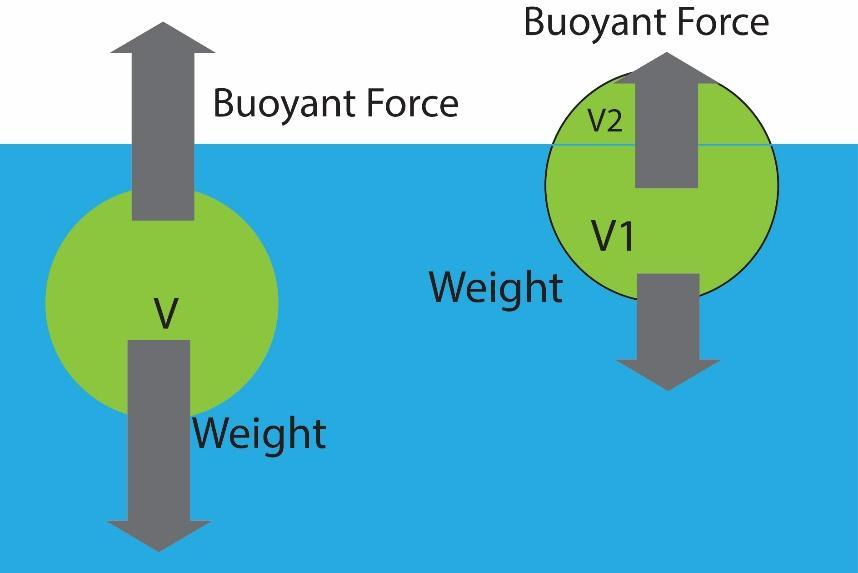
What do you mean by buoyancy?
Answer
509.7k+ views
- Hint: When we throw any object in water, we can observe that either the object will float or it will sink. We know the reason why an object sinks. It is because of its mass and earth's gravitational force. If an object floats, it is the buoyancy which enables the object to float.
Complete step-by-step solution -
Let us know about buoyancy in detail through practical approach. If we throw an object in water, the forces acting on the object are the gravitational force which acts downwards forcing the object to sink in water. But few objects do not sink. Instead they’ll float in water. This is because the downward gravitational force is balanced by an upward force called buoyant force. It is also known as upthrust. Generally, we know that pressure increases with depth as a result of the weight of the above lying fluid. Thus, the pressure at the bottom of a column of fluid is greater than that of the top of the column.
Similarly, the pressure at the bottom of an object submerged in a fluid is greater than that of the top of the object. The pressure difference results in a net upward force on the object. The magnitude of the force is proportional to the pressure difference and is equivalent to the weight of the fluid that would otherwise occupy the submerged volume of the object. This fluid is also known as the displaced fluid.

Simply we can say that buoyant force is equal to weight of the displaced fluid. When this buoyant force is sufficient to balance the downward gravitational force, the object floats. If not, it sinks. The gravitational force applied on an object of mass m is given by,
${{F}_{g}}=mg$ where g is gravitational constant whose value is $9.8m/{{s}^{2}}$ The buoyant force due to a liquid of density $\rho $ is given by,
${{F}_{b}}=V\rho g$
where V denotes the volume of displaced liquid, g is a gravitational constant whose value is $9.8m/{{s}^{2}}$.
Note: The most interesting and simple approach to understand buoyancy is by observing the submarine. It works on the principle of buoyancy. It has a large ballast tank. It is used to control the depth of the submarine. It submerges by allowing water into the ballast tank so that its weight becomes greater than the buoyant force.
Complete step-by-step solution -
Let us know about buoyancy in detail through practical approach. If we throw an object in water, the forces acting on the object are the gravitational force which acts downwards forcing the object to sink in water. But few objects do not sink. Instead they’ll float in water. This is because the downward gravitational force is balanced by an upward force called buoyant force. It is also known as upthrust. Generally, we know that pressure increases with depth as a result of the weight of the above lying fluid. Thus, the pressure at the bottom of a column of fluid is greater than that of the top of the column.
Similarly, the pressure at the bottom of an object submerged in a fluid is greater than that of the top of the object. The pressure difference results in a net upward force on the object. The magnitude of the force is proportional to the pressure difference and is equivalent to the weight of the fluid that would otherwise occupy the submerged volume of the object. This fluid is also known as the displaced fluid.

Simply we can say that buoyant force is equal to weight of the displaced fluid. When this buoyant force is sufficient to balance the downward gravitational force, the object floats. If not, it sinks. The gravitational force applied on an object of mass m is given by,
${{F}_{g}}=mg$ where g is gravitational constant whose value is $9.8m/{{s}^{2}}$ The buoyant force due to a liquid of density $\rho $ is given by,
${{F}_{b}}=V\rho g$
where V denotes the volume of displaced liquid, g is a gravitational constant whose value is $9.8m/{{s}^{2}}$.
Note: The most interesting and simple approach to understand buoyancy is by observing the submarine. It works on the principle of buoyancy. It has a large ballast tank. It is used to control the depth of the submarine. It submerges by allowing water into the ballast tank so that its weight becomes greater than the buoyant force.
Recently Updated Pages
Master Class 10 Computer Science: Engaging Questions & Answers for Success

Master Class 10 Maths: Engaging Questions & Answers for Success

Master Class 10 English: Engaging Questions & Answers for Success

Master Class 10 General Knowledge: Engaging Questions & Answers for Success

Master Class 10 Science: Engaging Questions & Answers for Success

Master Class 10 Social Science: Engaging Questions & Answers for Success

Trending doubts
Is Cellular respiration an Oxidation or Reduction class 11 chemistry CBSE

Raindrops are spherical because of A Gravitational class 11 physics CBSE

What are Quantum numbers Explain the quantum number class 11 chemistry CBSE

Why is steel more elastic than rubber class 11 physics CBSE

Explain why a There is no atmosphere on the moon b class 11 physics CBSE

Which of the following is most electronegative A Carbon class 11 chemistry CBSE




